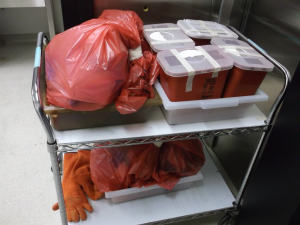Laboratory personnel must be aware of the potential for burns while handling hot sterilized items and use caution when removing them from autoclaves/sterilizers.
DOs
- Have a cart available to transport items to/from autoclave.
- Wear a lab coat and always use heat-resistant gloves to load/unload an autoclave.Gauntlets provide wrist and forearm protection for handling hot items.
- Ensure that the autoclave/sterilizer door is closed and locked prior to starting a cycle.
- Do not remove items from an autoclave until they have cooled.
- Use forceps or other tools to remove sharp instruments or broken glass from pans and autoclaves.
DON’Ts
- Do not leave biohazardous waste unattended. If the sterilizer is in use, please return the biohazardous waste to your laboratory.
- DO NOT change autoclave temperature to >250ºF.
- DO NOT shut off the autoclave at the end of your cycle.
- DO NOT adjust water/steam settings or valves.
- DO NOT autoclave liquids containing bleach, formalin, or glutaraldehyde.
- Do NOT autoclave flammable or volatile liquids.
- Do NOT autoclave radioactive materials.
- Do NOT autoclave items containing corrosives (acids, bases, or phenol).
- Do NOT OPEN the chamber door if water leaks from front of the autoclave. clogged lines, equipment malfunction or a failure in the steam supply may cause the autoclave chamber to fill with scalding water Failure to heed this warning may result in second- or third-degree burns from scalding water!
Training

If an autoclave is not operated correctly, your research or clinical materials could be compromised, the unit can become damaged and taken out of service, or worse, you could be badly injured. Geared to research staff, EH&S provides training conducted at the users' autoclave(s). The proper use of autoclaves as well as safety training is covered. Please contact the Biosafety Office (352-392-1591) to schedule a training session.
Autoclave Operation
- Collect biohazardous waste in red autoclave bags. Close the bags and place them in a sturdy, leak-proof tray or pan for transport to the autoclave. The autoclave tray or pan is used as secondary containment; do not overload these. Use a wheeled cart to transport bags/trays to and from autoclave. Always bring heat-resistant gloves with you to the unit.
- Autoclave bags must be closed, yet vented, to allow proper sterilization. Sealed bags will not allow penetration of steam and may explode during the exhaust step.
- Loosen the caps on all bottles as you load the autoclave. Sealed containers may explode in the autoclave or when you attempt to remove them.
- The inner contents of tightly sealed or covered containers will not be adequately sterilized.
- Do not place items directly on racks. Use autoclave trays for all sterilizations. Trays must be designated for use at 250ºF (e.g., polypropylene, polycarbonate, or stainless steel). Follow recommended sterilization times.
- Sharps containers & biohazardous waste bags must be labeled with the date, PI name, location (room/building) and telephone number.
- Update autoclave logbook (available near the autoclave) for each use of the autoclave as follows:
- Date, time, and operator’s name
- Contact information: Lab, room number, phone number
- Is this biohazardous material?
- EMERGENCIES/PROBLEMS
- During work hours, call EH&S (352-392-1591) regarding any mechanical problems/failures. EH&S will notify the approved vendor for service.
- For urgent and immediate assistance after hours or on weekends, please contact Facilities Services at 352-392-1121.
Recommended Gravity Cycle Sterilization Times (250ºF & 15PSI)
BIOHAZARDOUS WASTE (GRAVITY CYCLE)
| Multiple Bags |
100 Minutes or Longer |
| Single Bag |
90 Minutes |
| Partial Bag |
60 Minutes |
NON-POROUS ITEMS (GRAVITY CYCLE)
| Glassware, Empty, Inverted |
20 Minutes |
| Instruments, Wrapped |
30 Minutes |
| Utensils, Wrapped |
30 Minutes |
LIQUIDS (bottles with vented caps, ½ full)
| 75mL |
25 Minutes |
| 250mL |
30 Minutes |
| 500 mL |
40 Minutes |
| 1000mL |
45 Minutes |
| 1500mL |
50 Minutes |
| 2000mL |
55 Minutes |
Please note that Liquid cycles will take up to an additional 10-15 minutes to run than the set sterilization time due to slow charge and exhaust.
Site-Specific Autoclave Procedures
The Biosafety Office has detailed instruction sheets for UF’s more heavily used autoclaves.
The instruction sheets are NOT SUBSTITUTES for PROPER TRAINING. Schedule a training session by contacting our office.
Testing
Autoclave performance shall be tested before being placed into service and then periodically to ensure they are functioning as required:
- Every 40 hours of operation (Required for autoclaves that are used to inactivate human or non-human primate blood, tissues, clinical samples, or human pathogens.)
- Every 6 months (Required for autoclaves that are used to inactivate or sterilize other material.)
A commercially available test indicator kit that uses bacterial spores (Bacillus stearothermophilus) is the approved method of testing autoclave efficacy. Each batch of vials has an expiration date and should not be used after the expiration date. Bacterial spore vials can be ordered through EH&S using this order form.
Before placing a new autoclave into service, a mock load approximating the weight and density of the type of waste generated shall be autoclaved with test spore vials to determine the appropriate parameters for sterilization/inactivation. For solid waste simulation, the spore vial (within a vented, small autoclave bag) is placed in the center of the test load. The outer autoclave bag is vented and placed in a PP autoclave pan (in an otherwise empty chamber) and run through a sterilization cycle. To determine proper functioning and establish the required treatment times, a series of tests with increasing sterilization times must be performed and documented.
For periodic testing, place a spore vial in the very center of a test load prior to autoclaving.
Please contact EH&S for more information on autoclave efficacy testing.


